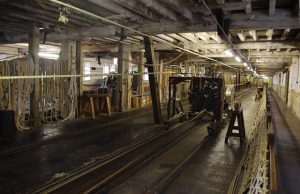In the earliest days of civilization, humans used to twist natural fibers by hand to create braids as a rope-making method.
Humans learned to use ropes from the primitive times when they were cave dwellers and used plant fibers as ropes that served all tying purposes. As civilization progressed, the manner of using plant fibers became more sophisticated to meet various new needs of tying heavier objects in different ways that resulted from evolving lifestyles. Ropes became most popular when people set sail on rafts that used ropes to tie logs and stay afloat. Ropes were the most crucial component of ships that relied heavily on them for their various operations, including hoisting the mast that holds the sail.
As ships were the most popular vehicle for traveling and carrying out trading activities, the demand for ropes increased exponentially. For example, a typical ship of the 19th century fully rigged with 25 sails would use miles of ropes for its operations.
Ropes have retained their importance over time, and despite modern machinery and vessels used for maritime ventures, the versatility of ropes remains unmatched.
Ropes are highly versatile
Whether you use Ravenox Ropes or ropes of any other brand, it uses some fiber, either natural or synthetic, with a considerable tensile strength that enables it to carry loads. Rope making methods consist of braiding or twisting several fibers of the same type to create a thick bundle and increase its length and strength. Ropes have versatile use in our lives and from homes to industries to the military; everyone uses some ropes to perform some activities. Even no wedding ceremony is complete without using a rope or cord created, especially for the handfasting ceremony, which is one of the ancient traditions that still holds good.
Rope manufacturing machines
In the earliest days of civilization, humans used to twist natural fibers by hand to create braids as a rope-making method. As times passed and civilization progressed, the use of ropes grow manifold, and to meet the increased demand and people started using machines for making ropes. The Ropery is the earliest rope making machine that is still in use. Despite using machines, rope making was a labor intensive process until the invention of advanced and automatic machines that increased the output dramatically and allowed using different fibers for manufacturing different types of ropes by using the same machine.

cc-by-sa/2.0 – © Ian Taylor – geograph.org.uk/p/3823833
Besides the ropery, the forming machine forms strands for rope, and the finishing is done with the help of closing machines that closes three strands to complete the process of rope making.
Types of ropes
Chatham Hemp rope – Flax fiber is the staple material for making Chatham hemp rope with high strength, durability, and fineness. Flax is a natural fiber obtained from the plant grown in sub-tropical regions across the globe. Flax was the chosen textile material until cotton challenged it in the nineteenth century.
Manila rope – Manila hemp obtained from the Abaca plant grown in the Philippines is the fiber used of making Manila ropes widely used in the marine and construction industry as well as paper-making industry
Sisal rope – The fiber obtained from the Sisal plant is used for making ropes used for agricultural purposes, especially for binding bales.
These are three of the popular types of ropes that people use.


Join the conversation!